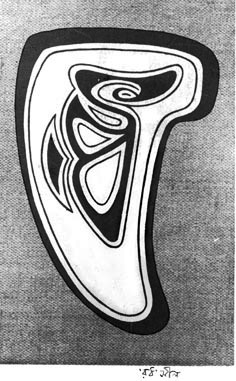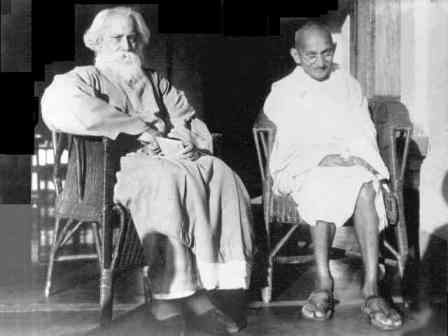 Rabindranath Tagore was born in Calcutta, into a wealthy Bengali Brahmin family. After a brief stay in England in an attempt to study law, he returned to India, and instead pursued his career as a writer, playwright, songwriter, poet, philosopher and educator. For the first 51 years of his life he achieved success only in Bengal. His short stories were published monthly in a friend's magazine. He was only a local hero.
Rabindranath Tagore was born in Calcutta, into a wealthy Bengali Brahmin family. After a brief stay in England in an attempt to study law, he returned to India, and instead pursued his career as a writer, playwright, songwriter, poet, philosopher and educator. For the first 51 years of his life he achieved success only in Bengal. His short stories were published monthly in a friend's magazine. He was only a local hero.
It was the year 1912. Tagore, then 51 years old, visited England. On the way over to England he began translating, for the first time, his latest selections of poems, Gitanjali, into English. All of his work prior to that time was written in Bengali. He did this only to pass his time, with no expectations at all. Tagore's friend in England, a famous artist he had met in India, Rothenstein, read the translations. He was astonished. The poems were incredibly good. He called his friend, W.B. Yeats, and asked him to have a look into Tagore’s work.
 The rest is history. Yeats was enthralled. He later wrote the introduction to Gitanjali when it was published in September 1912 in a limited edition by the India Society in London. Soon, both the poetry and the man were an instant sensation in the whole world. His spiritual presence was admired. His words evoked great beauty. Nobody had ever read anything like this before. A glimpse of the mysticism and sentimental beauty of Indian culture were revealed to the west for the first time.
The rest is history. Yeats was enthralled. He later wrote the introduction to Gitanjali when it was published in September 1912 in a limited edition by the India Society in London. Soon, both the poetry and the man were an instant sensation in the whole world. His spiritual presence was admired. His words evoked great beauty. Nobody had ever read anything like this before. A glimpse of the mysticism and sentimental beauty of Indian culture were revealed to the west for the first time.
Less than a year later, in 1913, Tagore received the Nobel Prize for literature. He was the first non-westerner to receive this honor. Overnight he was famous and began lecture tours across the world, promoting inter-cultural harmony and understanding. In 1915 he was knighted by the British King George V. In 1919, following the Jalianwala bagh massacre, Sir Tagore renounced his Knighthood.
Tagore primarily worked in Bengali, but after his success with Gitanjali, he translated many of his other works into English. He wrote over one thousand poems; eight volumes of short stories; almost two dozen plays and play-lets; eight novels; and many books and essays on philosophy, religion, education and social topics. Aside from words and drama, his other great love was music, Bengali style. He composed more than two thousand songs, both the music and lyrics. Two of them became the national anthems of India and Bangladesh. In 1929 he even began painting. Many of his paintings can be found in museums today, especially in India, where he is considered the greatest literary figure of India of all times.
 He used the funds from his writing and lecturing to expand upon the school called Visva Bharati, which he had established in 1901. It was an alternative to the education imposed by the British, which combined the best of traditional Hindu education with Western ideals.
He used the funds from his writing and lecturing to expand upon the school called Visva Bharati, which he had established in 1901. It was an alternative to the education imposed by the British, which combined the best of traditional Hindu education with Western ideals.

A good friend of Mr. M. K. Gandhi, Tagore preferred staying out of politics. He was against nationalism and miltiarism as a matter of principle, and instead promoted spiritual values and the creation of a new world culture founded in multi-culturalism, diversity and tolerance. He served as a spiritual and creative beacon to his countrymen, and indeed, the whole world.
The foundation of Tagore’s world-view was education. He firmly believed that independence from the British, in itself, would be meaningless and will merely lead to replacing a foreign oppressor with home-grown ones as long as Indians stayed mired in superstition, ritualism and were closed to new ideas. He strongly opposed Gandhi’s philosophy of “Education can wait, Swaraj cannot”.
Although an admirer of Gandhi as a person, he also publicly opposed Gandhi’s use of religion and his invocation of India’s past glories as a means to bring masses together. Having seen how nationalism, as defined by pride and cultural chauvinism, had led to suffering in the first half of the twentieth century both in Asia and in Europe, mostly from the nationalist movements in Japan and Germany.

Tagore’s criticism of Gandhian struggle was not just motivated by ideology but also on practical lines. In Bengal, the cloth trade had a strong Muslim presence and when Congress leaders asked people to burn clothes produced by British mills, many of the Muslim merchants refused just on economic grounds. These Muslims were later tagged as anti-nationals. Tagore had foreseen problems like these. Tagore was of the opinion that unless Indian industry had products that could compete in the market on their quality alone, it was unreasonable to ask people who had invested in the cloth trade to reject British-made goods just out of patriotism.
Tagore was a strong supporter of the Swadeshi movement in a different way. He, in-fact worked hard in promoting local industry and local education as an alternative to the British way. He became one of pioneers behind the National Council of Education, responsible for the foundation of Jadavpur University as an alternative to the Calcutta University based on the British way of education.
Gurudev Rabindranath Tagore was a poet, a song-writer, a novelist, a painter and a great idealist a cultural icon and a hero. His 40 volumes of poetry are the emblems of Bengali culture. He is the author of the national anthems of both India and Bangladesh. He is eternal and symbolic, and his work has spurred, in the generations that have followed.
